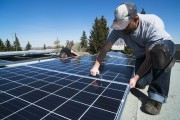Energy efficiency is one of the most valuable energy resources, saving money and reducing pollution the more it is used.
In recent decades, the global community has seen the benefits of employing energy efficiency, developing solutions and adapting approaches to barriers and challenges as they arose.
Aside from brief fits and starts, Alberta has not developed energy efficiency. Now we can catch up, and we are in a position to take advantage of lessons learned around the world. Will Alberta seize the opportunity to lead this resource’s development, catch up to other jurisdictions and even bypass them in developing this under-utilized resource?
To enable Alberta to grow energy efficiency to its full potential, the Pembina Institute has examined global best practices while applying an Alberta lens. We spoke with thought leaders in industry, research and government and collected information from internationally recognized institutions and think tanks resulting in our recent report: Kick-starting Energy Efficiency in Alberta, containing recommendations for the province.
In the course of our research common themes emerged. Taking advantage of energy efficiency includes establishing energy efficiency programs, codes and standards, new financing policy, integrating energy efficiency into the utility system, and a government that leads by example.
Given the current state of Alberta’s neglected energy efficiency resource and the nature of energy use in the province, we have identified energy efficiency programs and integration of energy efficiency into the utility system as the most effective ways to successfully implement energy efficiency in Alberta.
Typically, energy efficiency programs consist of educational campaigns on the benefits of energy efficiency, financial incentives like rebates that make energy efficiency more affordable, technical services to deploy energy efficiency (e.g., retrofits and training), and data (e.g., information on personal energy use) that can help people know how to adapt their homes and behaviour to conserve energy.
The Government of Alberta is on the right track to enable energy efficiency programs with the recently established arm’s-length organization, Energy Efficiency Alberta (EEA). To ensure it is successful, it should be ambitious in its goal-setting, measure and communicate program results, and establish a stakeholder group.
But beyond a successful agency, realizing the full potential of energy efficiency in Alberta relies on recognizing energy efficiency as a resource. We should integrate it into the utility system, as has been done in almost every other U.S. and Canadian jurisdiction. It means taking energy efficiency into consideration as an alternative practice when investment decisions are made on transmission and distribution infrastructure, or to meet the need for electricity production capacity. Doing so will reduce consumer costs by reducing the need for unnecessary production and infrastructure investment.
There are two ways to integrate energy efficiency into the utility system in Alberta. In the best case, energy efficiency should be pursued whenever it is the most cost-effective investment decision compared to other system’s resources. Further, the government can establish a mandate for the regulator, system operator and consumer advocate to pursue energy efficiency and include energy efficiency into the deregulated electricity market, allowing it to compete to provide capacity.
Perhaps it’s wishful thinking that we will seize on this opportunity to become a resource leader on an entirely new front. I believe we have what it takes to emerge as a leader in energy efficiency — one of the most valuable resources.
Read the full report: Kick-starting energy efficiency









